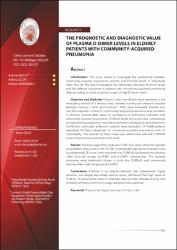| dc.date.accessioned | 2023-05-26T08:06:02Z | |
| dc.date.available | 2023-05-26T08:06:02Z | |
| dc.date.issued | 2022 | en_US |
| dc.identifier.uri | https://search.trdizin.gov.tr/tr/yayin/detay/1169767/the-prognostic-and-diagnostic-value-of-plasma-d-dimer-levels-in-elderly-patients-with-community-acquired-pneumonia | |
| dc.identifier.uri | https://hdl.handle.net/20.500.12868/2196 | |
| dc.description.abstract | Introduction: This study aimed to investigate the relationship between community-acquired pneumonia severity and D-dimer levels in individuals older than 65. We also investigated the relationship between D-dimer levels and the adverse outcomes in patients with community-acquired pneumonia after excluding all other potential causes of high D-dimer levels. Materials and Methods: Patients older than 65 who were admitted to the emergency service of a tertiary chest diseases training and research hospital between January 1, 2019, and October 1, 2020, were evaluated. Patients who met the diagnostic criteria for community-acquired pneumonia were included. In clinically questionable cases of coexistence of pulmonary embolism and community-acquired pneumonia, D-dimer levels and pulmonary computerize tomography angiography or ventilation-perfusion scintigraphy were examined. Confirmed pulmonary embolism patients were excluded. Of 4,608 patients evaluated, 82 had a diagnosis of community-acquired pneumonia with no comorbidity. The severity of these cases was determined with the CURB-65 score and pneumonia severity index score. Results: The mean age of the cases was 73.83±6.67 years, while their gender was predominantly male (n=51, 62.2%). A statistically significant correlation was found between D-dimer levels and both the CURB-65 and pneumonia severity index high-risk groups (p=0.001 and p=0.001, respectively). The adverse outcomes were statistically higher in both the CURB-65 and pneumonia severity index high-risk groups (p<0.001). Conclusions: D-Dimer is an easy-to-interpret, fast, inexpensive, highly sensitive, and simple test widely used in clinics. We found that high levels of D-dimer can predict the need for intensive care unit care, disease severity, and mortality of elderly community-acquired pneumonia patients. | en_US |
| dc.language.iso | tur | en_US |
| dc.relation.isversionof | 10.31086/tjgeri.2022.284 | en_US |
| dc.rights | info:eu-repo/semantics/openAccess | en_US |
| dc.subject | Pneumonia | en_US |
| dc.subject | Aged | en_US |
| dc.subject | Severity of Illness Indekx | en_US |
| dc.title | The Prognostic and Diagnostic Value of Plasma D-Dimer Levels in Elderly Patients with Community-Acquired Pheumonia | en_US |
| dc.type | article | en_US |
| dc.contributor.department | ALKÜ, Fakülteler, Tıp Fakültesi, Dahili Tıp Bilimleri Bölümü | en_US |
| dc.identifier.volume | 25 | en_US |
| dc.identifier.issue | 2 | en_US |
| dc.identifier.startpage | 262 | en_US |
| dc.identifier.endpage | 273 | en_US |
| dc.relation.journal | Türk Geriatri Dergisi | en_US |
| dc.relation.publicationcategory | Makale - Uluslararası Hakemli Dergi - Kurum Öğretim Elemanı | en_US |


















